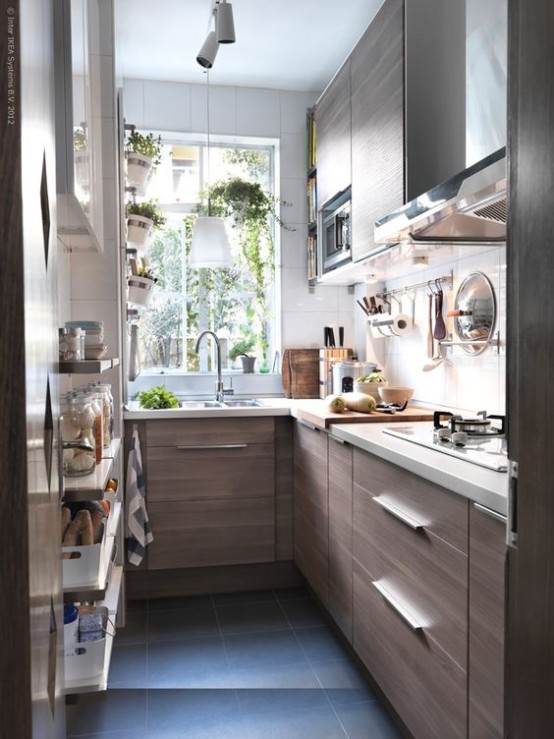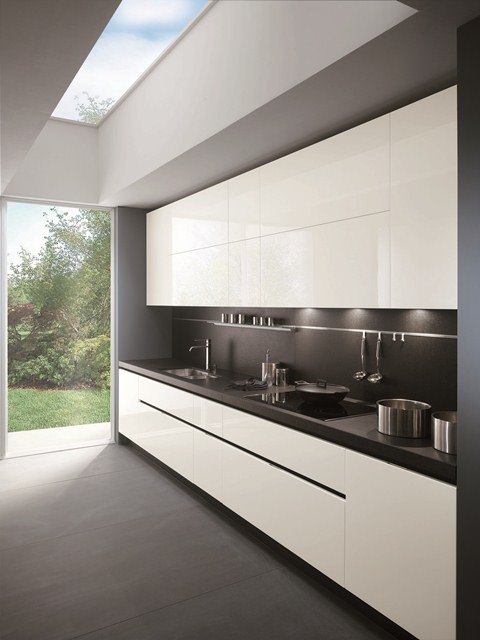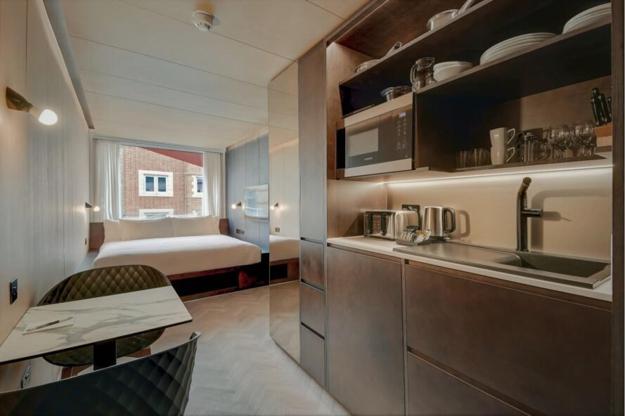When it comes to minimalist kitchen cabinet design, the phrase “less is more” truly comes into play. Minimalism in the kitchen doesn’t mean sacrificing style or functionality. In fact, I believe that the minimalist approach can enhance both. The idea is to focus on clean lines, uncluttered surfaces, and the efficient use of space, all while creating a calm and inviting atmosphere. In a kitchen, cabinets take up the most visual space, so adopting a minimalist design can make a huge impact on the overall look and feel of the room. The goal is to achieve simplicity without feeling sparse, which can be tricky but entirely possible with the right design elements.
One of the key principles of minimalist kitchen cabinet design is the use of smooth, flat surfaces. I’ve found that flat-front cabinets, often referred to as slab cabinets, are a hallmark of this style. They have no raised panels, trims, or ornate details, which keeps the overall look very sleek. This design emphasizes functionality while avoiding anything superfluous. I’m particularly drawn to how these cabinets create a clean, uninterrupted flow in the kitchen. Without the distractions of traditional cabinet details, the focus shifts to other elements of the kitchen, like the countertops or backsplash, allowing those features to shine.

Another important aspect of minimalist kitchen cabinets is the choice of materials and finishes. Natural materials like wood, metal, and glass often play a big role in minimalist design. I’ve always been a fan of how these materials can add warmth and texture without overcomplicating the design. For instance, light-colored woods, like birch or maple, can give a minimalist kitchen a sense of softness and warmth, while still keeping things simple. On the other hand, if you want a more modern, edgy feel, matte or glossy finishes in neutral colors, like white, gray, or black, are perfect for creating a more contemporary minimalist look.
The color palette in minimalist kitchen cabinet design is typically very restrained. Neutral tones dominate this style, with white being the most popular choice. I love how white cabinets make the kitchen feel open, bright, and airy. White is clean and timeless, and it creates a blank canvas that allows other design elements to stand out. However, minimalist design doesn’t necessarily mean everything has to be white. Shades of gray, black, or even muted earth tones can work beautifully in a minimalist kitchen, especially if you’re looking for something a bit more grounded or sophisticated. The key is to stick to a limited color palette to maintain that sense of calm and simplicity.

One design trick I’ve always admired in minimalist kitchens is the use of hidden storage. In minimalist design, the last thing you want is clutter, and that includes visual clutter. Cabinets with hidden handles or touch-to-open mechanisms are perfect for keeping things streamlined. I particularly like handleless cabinets, where the design relies on push mechanisms or integrated grooves to open doors and drawers. This not only contributes to the clean, modern look but also makes the kitchen feel less busy and more cohesive. It’s little details like these that really enhance the minimalist aesthetic without compromising on functionality.
Integrated appliances are another element that can elevate minimalist kitchen cabinet design. I find that in a truly minimalist kitchen, you don’t want the appliances to stand out as separate entities. Instead, integrating them into the cabinetry can help create a seamless flow. Built-in refrigerators, dishwashers, and even microwaves can be concealed behind cabinet doors, which maintains the minimalist look. I love how this approach allows the focus to remain on the overall design of the kitchen, rather than individual appliances. It’s all about creating a cohesive environment where everything feels like it belongs together.

Open shelving is often debated when it comes to minimalist kitchens. Some people think it adds too much visual clutter, while others believe it can enhance the minimalist feel by showcasing only the most essential items. Personally, I think open shelving can work beautifully in a minimalist kitchen if done thoughtfully. The key is to keep it sparse and organized. I like the idea of using open shelves to display a few well-curated pieces, like ceramic dishes or glassware, that complement the overall design. However, if open shelving isn’t for you, opting for closed cabinets with clean lines is always a safe bet for maintaining that minimalist aesthetic.
Lighting plays a critical role in minimalist kitchen cabinet design as well. I’ve noticed that minimalist kitchens often rely on natural light to make the space feel open and airy, but artificial lighting is just as important. Under-cabinet lighting, for example, is a great way to illuminate workspaces without adding any visual bulk. I also like using simple pendant lights or recessed lighting to keep the design clean and uncluttered. When it comes to lighting, it’s about enhancing the functionality of the kitchen without drawing too much attention to the fixtures themselves. The right lighting can make a minimalist kitchen feel warm and inviting, rather than cold or sterile.
Storage solutions are another important consideration in minimalist kitchen cabinet design. With minimalism, you want to avoid clutter, but that doesn’t mean sacrificing storage space. I’ve found that deep drawers, pull-out pantry systems, and corner cabinets with lazy Susans are excellent ways to maximize storage without compromising the minimalist look. The key is to keep everything organized and out of sight. In a minimalist kitchen, every item should have its own place, and keeping countertops free from unnecessary items is essential. This way, the kitchen feels open and functional, without being overwhelmed by stuff.

Textures and materials play a subtle yet important role in minimalist kitchen cabinet design. Since the design itself is so streamlined, I find that introducing texture in a thoughtful way can add depth and interest to the space. For example, using a matte finish on the cabinets can create a soft, muted effect, while a glossy finish can make the kitchen feel more polished and modern. Similarly, incorporating natural materials like wood or stone can add warmth and contrast to the otherwise minimalist palette. I particularly like the idea of mixing matte cabinets with a textured backsplash or countertop to create a balanced, harmonious look.
Minimalist kitchens are often associated with modern or contemporary design, but they can also work in more traditional or transitional spaces. I’ve seen minimalist cabinetry paired with more classic elements, like a farmhouse sink or vintage hardware, to create a kitchen that feels both modern and timeless. The key is to maintain the clean lines and uncluttered surfaces that are central to minimalist design, while incorporating subtle touches of warmth or character. This blend of old and new can make a minimalist kitchen feel more approachable and lived-in, without sacrificing the simplicity and functionality that define the style.
Incorporating sustainable materials is another trend I’ve noticed in minimalist kitchen design. More and more people are opting for eco-friendly materials, such as bamboo or recycled wood, for their cabinetry. I love how these materials not only contribute to a clean, natural look but also align with the minimalist philosophy of using fewer resources and creating less waste. Choosing sustainable materials can make a minimalist kitchen feel more connected to nature and the environment, while still achieving that sleek, modern aesthetic. It’s a win-win for those who value both style and sustainability.

Minimalist kitchen cabinet design also focuses on functionality. Every design choice should serve a purpose, whether it’s maximizing storage space or improving workflow. In a minimalist kitchen, everything should have its place, and there should be no unnecessary features or decorations. I appreciate how this approach can lead to a more efficient kitchen where everything is easily accessible and organized. For example, I like to use pull-out shelves in lower cabinets or install drawer dividers to keep utensils and cookware neatly arranged. These small details can make a big difference in the overall functionality of the kitchen, while still maintaining a clean, uncluttered look.
Another key aspect of minimalist kitchen cabinet design is the focus on quality over quantity. Instead of filling the kitchen with lots of cabinetry, I prefer to focus on fewer, high-quality pieces that will stand the test of time. This not only contributes to the minimalist aesthetic but also ensures that the kitchen remains functional for years to come. I find that investing in high-quality materials and finishes can elevate the entire space, making it feel more luxurious without being overwhelming. Whether it’s choosing solid wood for the cabinets or opting for soft-close hinges, these small details can make a big difference in the long run.
Finally, one of the things I love most about minimalist kitchen cabinet design is how adaptable it is. Whether you’re working with a small kitchen or a larger space, minimalist cabinets can be tailored to suit your needs. In a smaller kitchen, minimalist cabinets can make the space feel larger and more open, while in a bigger kitchen, they can create a sense of balance and harmony. I’ve found that minimalist design works well in all types of kitchens because it focuses on simplicity, functionality, and timeless appeal. By sticking to clean lines, neutral colors, and high-quality materials, you can create a kitchen that feels both modern and inviting.

Common Mistakes to Avoid
One common mistake I’ve seen people make when designing a minimalist kitchen is focusing too much on aesthetics and not enough on functionality. Minimalism is about more than just clean lines and neutral colors; it’s also about creating a space that works for you. Another mistake is overcrowding the space with too many cabinets. While storage is important, minimalist design should feel open and uncluttered, so resist the urge to overfill your kitchen with cabinetry. Additionally, using low-quality materials can undermine the minimalist aesthetic. Minimalist design is about quality over quantity, so it’s better to invest in fewer, high-quality pieces than to fill the space with cheaper, less durable options.
Another common pitfall is not planning for enough storage. While minimalist kitchens are all about simplicity, you still need enough space to store your kitchen essentials. Skimping on storage can lead to clutter, which is the opposite of what minimalist design is trying to achieve. Lastly, don’t forget about lighting. Poor lighting can make even the most beautifully designed kitchen feel cold and unwelcoming. Make sure to incorporate a mix of natural and artificial lighting to create a warm, inviting atmosphere in your minimalist kitchen.

What colors work best for minimalist kitchen cabinets?
Neutral colors like white, gray, and black are popular choices for minimalist kitchen cabinets. These shades create a clean, uncluttered look that’s central to minimalist design. However, light wood tones or muted earth colors can also work well if you want to add warmth without compromising the minimalist aesthetic.
Can a minimalist kitchen be functional?
Yes, a minimalist kitchen can be very functional. The key is to focus on the efficient use of space and storage. Minimalist kitchens often use smart storage solutions like pull-out drawers and hidden cabinets to keep everything organized and out of sight, making the kitchen both practical and uncluttered.
How do you maintain a minimalist kitchen design?
Maintaining a minimalist kitchen design requires regular decluttering and organizing. Keep countertops clear and only display essential items. Make sure everything has its own designated storage space to avoid visual clutter and stick to a neutral color palette to keep the space feeling calm and cohesive.

Is minimalist kitchen design expensive?
Minimalist kitchen design doesn’t have to be expensive. While high-quality materials and finishes can come at a higher price, the overall design focuses on simplicity and function, which can reduce costs. Investing in fewer, higher-quality pieces can also save money in the long run by avoiding frequent replacements.
Can minimalist kitchen cabinets work in small spaces?
Absolutely. In fact, minimalist cabinets can be ideal for small kitchens because they make the space feel larger and more open. By focusing on clean lines and uncluttered surfaces, minimalist design can create the illusion of more space, even in a smaller kitchen.
What’s the difference between minimalist and modern kitchen design?
While both minimalist and modern kitchen designs emphasize clean lines and simplicity, minimalist design focuses more on reducing visual clutter and using only the essentials. Modern design can incorporate more decorative elements, whereas minimalist design strips everything down to its most functional form

Oak Kitchen Cabinets Doors Replacement kitchen cabinet doors

Kitchen Modern Minimalist Furniture Inspiration – Interior Design

Related Posts:
- Pro Build Kitchen Cabinets
- Used Kitchen Cabinets Naples Fl
- Cabin Style Kitchen Cabinets
- Painting Over Oak Kitchen Cabinets
- Kitchen Cabinet Importers
- Kitchen Radio Under Cabinet Bluetooth
- Kitchen Cabinets Kent Wa
- Complete Kitchen Cabinets For Sale
- Mirror Front Kitchen Cabinets
- Refinishing Maple Kitchen Cabinets